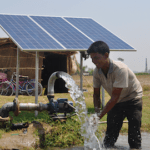Securitization for Social Impact: Why It’s the Ideal Instrument for Scaling Social Enterprises Providing Consumer Financing in the Developing World
Raising funds for business expansion has been especially challenging in recent years. Based on conversations with investors and our own first-hand experience at d.light, funding rounds are taking considerably longer to complete compared to the pre-pandemic era, with investors growing increasingly reluctant to part with their cash.
The past year proved to be no different. Economic uncertainty in 2023 led to a risk-averse approach from investors — Crunchbase data revealed that global startup funding last year was at its lowest level since 2018. With capital currently hard to come by, founders and business leaders are searching for alternative sources of finance that will allow them to scale responsibly.
One financial instrument that is yielding returns for businesses and investors alike is securitization. This is the process of transforming a group of cash-generating assets into one investable security, with investors receiving 100% of the money collected from the customer until the investor’s principal and interest is repaid. This kind of solution can work for companies that collect regular payments from their customers for products purchased with consumer financing, or that have other income-generating assets, like carbon credits, that are generated by a project over time.
In this approach, the income-generating assets are sold to a special purpose vehicle (SPV) — a separate legal entity created by the company that allows multiple investors to pool their capital to invest in it. Once the SPV purchases the receivables, the company no longer owns that asset. The company receives an infusion of capital through an “advance rate” paid when the SPV purchases receivables from the company, representing the value of the cash that will be generated by these assets while they’re owned by the SPV. The advance rate paid by the SPV is not recorded as a loan on the company’s balance sheet, since it is the upfront portion of the purchase price for a cash-generating asset – the receivables. That means the advance rate is not a liability of the company, and investors have no recourse to the company’s other assets if it’s not repaid. Once the principle plus interest is paid to the investors in the SPV, the asset is “sold” back to the company and the remaining collections from these customers accrue to it. This structure ensures that the company is incentivized to collect on the receivables even after they are sold to the SPV.
Adopting this approach equips enterprises with the capital to expand, while also lowering the cost of borrowing without inflating their liability, since the debt used to purchase the customer receivables is off balance sheet. This can unlock their ability to scale, which for social enterprises can create more opportunities to transform lives and act as a force for good. In that sense, securitization can be seen as a tool for enacting positive change.
How Securitization Provided a Fiscal Lifeline During the Pandemic
When d.light first opted to pursue securitization as a source of financing for expansion three and a half years ago, it was in response to a series of external events that had caused our growth to plateau.
At that point we were in the midst of the COVID pandemic, and its impacts were beginning to take full effect, as investors scaled back their investments in response to the inevitable downturn that was to follow. Currency devaluations and political unrest were among the other factors limiting our growth potential, increasing the difficulty of scaling on the African continent — d.light’s primary market.
Despite the obvious challenges, we were reluctant to let momentum stall and wanted to continue growing the business. This led us to consider alternative methods of financing, which is how we came to see securitization as a viable option for expansion.
This decision proved to be a watershed moment for d.light, with securitization providing the funds that powered our growth in a time when most businesses were solely focused on survival. Since 2020 we have raised more than $500 million of securitized funding, allowing for further expansion and entry into new markets. We are also pleased to report that d.light has now fully repaid lenders in our first securitized facility, BLK1. We are the first company in our industry to complete this milestone, and this achievement is a proof point that will attract more commercial lenders into similar structures in the future.
Lower costs for businesses, less risk for creditors
Securitization is an increasingly popular option for commercial enterprises and traditional businesses alike, because it is a mutually beneficial process for both the business raising the capital and the creditor providing the funds.
The creditor’s investment is guaranteed against current and future customer collections, which are transferred on a daily basis to the SPV. This structure removes concerns about where a business sits on its path to profitability, since lenders are repaid from customer collections, not from cash generated by the business. Even if the business generating the receivables goes bankrupt, the lenders can have an alternative service provider collect the remaining receivables balance. Securitization creates less risk for the lender than traditional sources of finance such as bank loans, as customer collections are immediately used for repayment of the loan, with the securitized asset acting as collateral for their investment.
The risk for the business itself is also lower, as securitized structures wind down automatically, meaning they’re gradually paying down the loan from customer collections, which eliminates any refinancing risk. Funds are secured against customer accounts receivable sold to the SPV facility. And as mentioned above, since the SPV is a separate entity from the business, with the SPV and its investors owning the receivables that are sold to it each month, it does not inflate the company’s liability or leave any of its other assets exposed.
For businesses like d.light with a large number of reliable, repeating customer payments, securitization also lowers the cost of borrowing money. Unlike private equity, securitization does not involve giving up a percentage of the company in exchange for cash. As a result, there is less dilution to equity owners and a higher percentage of profits can be reinvested in the business.
We’ve also found that securitization is a more flexible form of financing than private equity and traditional loans. The customer payments related to any accounts receivable we sell to an SPV facility are used to pay back the cash that d.light receives from that facility upfront. As part of this arrangement, d.light can elect which customer receivables we would like to sell to the facility each month, allowing flexibility as our financing needs evolve over time.
Additionally, the local currency structure of the deals leaves businesses like d.light less exposed to currency devaluations, which can adversely impact companies that generate receivables in local currency, but raise debt in hard currency.
The social impact of securitization
Securitization is well-suited to the needs of social enterprises because it facilitates expansion in a way that is affordable for customers and sustainable for the business itself.
When businesses are genuinely impactful, it is important that they find a reliable vehicle for growth that allows them to enter new markets and gain access to more consumers whose lives they can improve with their offering.
In the off-grid solar space, where almost all product sales are financed to the customer, resources, scale and deep pockets are all essential for advancing the rollout of products to remote low-income households and communities in the Global South. Since securitization can provide a reliable source of this needed funding, it can be an effective way to increase the number of lives transformed by a social enterprise — and to generate a positive return for the investor as well.
Facilitating the entry of off-grid solar providers into new markets also supports developing countries in achieving the United Nations’ Sustainable Development Goals, one of which calls for “affordable, reliable, sustainable and modern energy for all” by 2030.
Partnerships with investment groups such as African Frontier Capital have yielded significant returns, in terms of both d.light’s ability to scale and the profits we’ve generated for investors. With their assistance, we can expand our ability to deliver opportunities for the developing world and improve the lives and livelihoods of low-income households. Our success in using securitization should encourage businesses in similar sectors with similar profiles to explore the same route.
Ron Pfende is Chief Financial Officer at d.light.
Photo courtesy of DIVatUSAID
- Categories
- Investing, Social Enterprise



